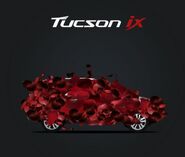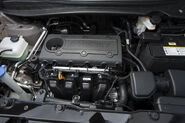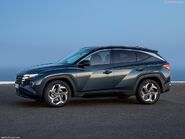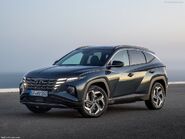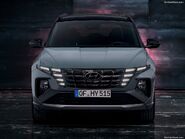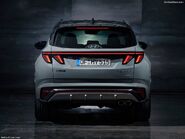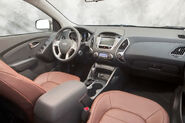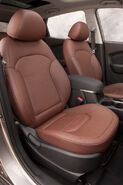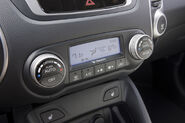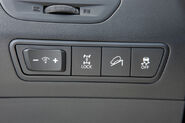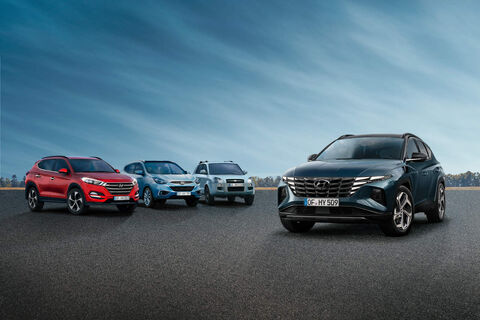
The Hyundai Tucson (Korean: 현대 투싼) (pronounced Tu-són) is a compact crossover SUV (C-segment) produced by the South Korean manufacturer Hyundai since 2004. In the brand's lineup, the Tucson is positioned below the Santa Fe, and above the Kona and Creta. It is named after the city of Tucson, Arizona. The second-generation model has been marketed as the Hyundai ix35 in several markets, including Europe, Australia and China, before reverting to Tucson for the third-generation.
The Tucson is the best-selling Hyundai SUV model, with more than 7 million units sold globally since it launched in 2004. Of these, 1.4 million units have been sold in Europe.
Recent Changes[]
- Though not expected to be unveiled until the 2009 Frankfurt Motor Show, Hyundai has released teaser images of the forthcoming second-generation model, variously dubbed ix35 (Europe) and Tucson ix (Korea), as early as the Pebble Beach Concours d'Elegance weekend. No details are available yet save for the already common knowledge that the new CUV will take its styling from the ix-onic concept car shown in Geneva. The new car was designed under Hyundai design director Oh Suk-Geun. The new generation was arrived in 2021[1][2][3]
Changes for 2006 were minimal. The LX became the Limited and got color-coded cladding, automatic climate control, and a high-performance sound system . The GLS retained the gray cladding but 'HYUNDAI' is no longer branded into the cladding on the front doors. The GLS also got improved cloth seats with the option of a heating element. Both GLS and Limited got redesigned alloy wheels. The base GL remains unchanged.
For 2007 the GLS was moved down to replace the GL, and the SE was introduced to take the place of the GLS as the middle trim. Cosmetically, as the Tucson was only introduced in 2005, not much has changed. The major changes include 3 new exterior colors to choose from, and some upgrades to interior items such as the audio system.
Styles and Major Options[]
The 2007 Tucson comes in three different trims: the GLS, SE, and Limited. The standard for the GLS is a 2.0L 140hp I-4 engine and a 5-speed manual transmission, while the SE and Limited are powered by a 2.7L 173hp V6 and 4-speed automatic. All models are equipped with a base front wheel drive with an option for and automatic full-time four wheel drive. Some of the standout features for each trim include:
GLS
- 16" silver alloy wheels
- Cloth seating and door trim
- Full floor console
- Cargo concealed storage
- 6-speaker AM/FM/CD audio system
- Tilt steering wheel
- Speed sensitive wipers
SE
Adds to or replaces GLS features with:
- Premium cloth seating
- Metal-look dashboard insert
- Leather shift knob and steering wheel
- Cargo net
- Manual front air conditioning
- 6-speaker AM/FM/Casette/MP3/CD audio system with automatic equalizer
- Trip computer
Limited
Adds to or replaces SE features with:
- Heated front seats
- Leather seating and door trim
- Auto-dimming day-night rearview mirror
- Roll-up cargo cover
- Automatic air conditioning
- Compass and exterior temperature monitor
- Wiper park
Pricing[]
Add more fields as necessary.
| MODEL Trims | |||||
|---|---|---|---|---|---|
| GLS Manual | GLS Auto | GLS w/ Pop. Equip. | GLS w/ Navi. Pkg. | Limited | Limited w/ Premium Pkg. |
| MSRP | |||||
| $18,995 FWD | $19,995 FWD | $21,695 FWD $23,195 AWD |
$23,695 FWD $25,195 AWD |
$24,345 FWD $25,845 AWD |
$27,195 FWD $28,695 AWD |
| Invoice | |||||
| $Price1 | $Price2 | $Price3 | $Price4 | $Price5 | $Price6 |
Gas Mileage[]
Add more fields as necessary.
As seen on the FuelEconomy.gov website, the City/Highway MPG averages are as follows:
| Trim | |||
|---|---|---|---|
| FWD | AWD | Trim3 | Trim4 |
| MPG | |||
| 23/31 | 21/28 | c/h | c/h |
Engine and Transmission[]
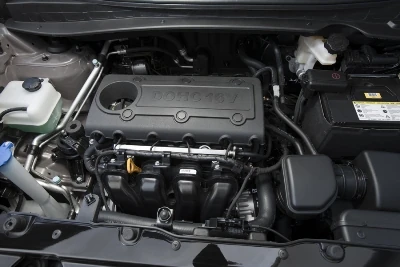
The Tucson is initially powered by Hyundai's 2.4 litre Theta II Inline-4 which produces 176 hp @ 6000 rpm and 168 lb-ft. of torque @ 4000 rpm mated to either a 6-speed Manual or a 6-speed automatic transmission with SHIFTRONIC®, with power routed to either the front wheels or all four. A 2.0 litre Inline-4 is expected to join the powertrain list later in the year.
Performance[]
Please make sure to write information of the vehicle's performance in a third-person point of view. This section should include information about the car's acceleration figures, handling, braking, etc.
If using information gathered from Road Test articles from a reputable automotive source, then please make sure to cite the quote.
Reliability[]
The 2010 Hyundai Tucson is protected by the Hyundai Advantage. Coverage includes five-year/60,000-mile bumper-to-bumper protection, 10-year/100,000-mile limited powertrain warranty, and seven-year/unlimited mileage anti-perforation coverage. In addition, Tucson buyers receive 24-hour roadside assistance coverage at no extra charge for five years (no mileage limit) and that service includes emergency towing, lockout service and limited coverage for trip-interruption expenses. There is no deductible on any of these coverages. Now it 5 years for the two garantie
Safety[]
The Tucson received very high marks from the NHTSA in safety tests carried out by the organization. For all front- and side-impact crash tests, the Tucson received 5-Star ratings, and in tests for rollover, the Tucson received 4-Star ratings for both two wheel drive and four wheel drive. Some of the standard safety features found on the tucson include:
- Traction control
- Electronic stability control
- Front and rear anti-roll bars
- Four wheel anti-lock brakes
- Driver/passenger front-impact airbags
- Driver/passenger seat-mounted side-impact airbags
- 1st/2nd row overhead airbags
- Occupancy sensors
- Side impact bars
Photos[]
2021 Tucson
N-Line
Colors[]
Colors will vary by trim, and a full list is viewable at CarsDirect.com. Some of the possible choices include:
Exterior
- Alpine Frost
- Brilliant Copper
- Desert Sage
- Nautical Blue
- Nordic White
- Platinum
- Stone White
Interior
- Beige
- Gray
Main Competitors[]
- Honda Element
- Toyota RAV4
- Ford Escape
- Mazda Tribute
- Jeep Liberty
- Mazda Tribute
- Honda CR-V
- Subaru Forester
Hybrid Models[]
There are currently no hybrid models of the Tucson in production.
Unique Attributes[]
If there are any features of this vehicle that sets it apart from other vehicles in its class, then mention those unique attributes here.
Interior[]
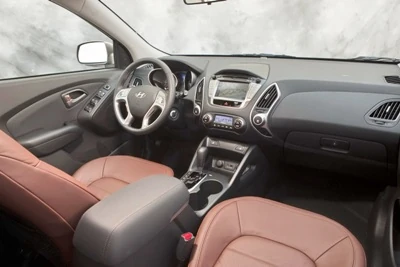
This section should include information on the interior's design, build quality, ergonomics, space (head and legroom, front and rear), features, stowage compartments and overall comfort and livability. Add pictures wherever applicable and keep information in a third-person point of view.
Resale Values[]
According to Kelley Blue Book, the Tucson is expected to "retain 55 percent of its original value at 24 months and 40 percent at 48 months. The V6 GLS and Limited four wheel drive models fare better, holding 59 percent at 24 months and 44 percent at 48 months."
| <MODEL> Year | |||
|---|---|---|---|
| Year X | Year X-2 | Year X-3 | Year X-4 |
| Resale Value | |||
| $ | $ | $ | $ |
Criticisms[]
- "Being car-based and with no 4WD-low setting, we wouldn't advise heavy-duty off-roading or attempting to climb over fallen limbs." - Cars.com
- "Leather reminded us of vinyl as much as cowhide, and interior plastics are hard and uninviting to the touch." - AutoWeek
- "Like other small SUVs, the Tucson isn't really a contender for offroad treks, despite its 7.8-inch ground clearance when equipped with four-wheel drive. Comfortable enough on the road with its soft and easy-riding suspension, the Tucson doesn't feel particularly sporty in regular driving." - Kelley Blue Book
- "Hyundai must improve its steering, which provides nothing you could describe as "feel"; it's a rubbery and disconnected experience." - AutoWeek
Generations[]
Fill in as many as appropriate. Add more if necessary and pictures wherever applicable.
Please make sure NOT to use copyrighted pictures.
Fourth generation (NX4; 2021-Present)[]
The fourth-generation Tucson was revealed on 14 September 2020. The all-new model features Hyundai's "jewel-like" grille, with geometric daytime running lights integrated in its design. Hyundai's design team, led by Sangyup Lee, its senior vice president and head of Hyundai Global Design Center, has reshaped the Tucson with bulging fenders, angled wheel wells, a level roofline and short overhangs. Prior to its release, the fourth-generation Tucson was previewed as the Vision T Concept showcased at the 2019 Los Angeles Auto Show in November 2019.
Riding on a shortened version of the N3 platform shared with the larger Santa Fe, the fourth-generation Tucson is offered with two wheelbase length for different markets to meet different customers needs and expectations in different regions, which are short-wheelbase (2,680 mm [105.5 in]), and long-wheelbase (2,755 mm [108.5 in]). Most regions outside Europe, Middle East and Mexico will receive the long-wheelbase version. In China, the long-wheelbase-only fourth-generation Tucson is marketed as the Tucson L to differentiate itself with the older model.
Markets[]
Europe[]
Continued to be produced at Hyundai Motor Manufacturing Czech, the European-market Tucson is solely offered with the short 2,680 mm (105.5 in) wheelbase version. The European range of the fourth-generation Tucson includes five electrified powertrain options, as well as one petrol and one diesel.
The base options are the petrol 1.6-liter T-GDi (turbocharged gasoline direct injection) with 147 hp (149 PS; 110 kW) engine and the diesel 1.6-liter CRDi with 113 hp (115 PS; 84 kW). Both engines are also offered with a mild hybrid 48-volt technology, which include the petrol 1.6-liter T-GDi in 147 hp (149 PS; 110 kW) and 177 hp (179 PS; 132 kW) versions, and the diesel 1.6-liter CRDi with 134 hp (136 PS; 100 kW). Mild hybrid petrol models is fitted with the 6-speed Intelligent Manual Transmission (iMT) as standard.
At launch, the most powerful Tucson is the hybrid 1.6-liter T-GDi HEV, which combines the turbocharged petrol engine with a 59 hp (60 PS; 44 kW) electric motor and a 1.49 kWh lithium-ion polymer battery for a system output of 226 hp (229 PS; 169 kW). The hybrid Tucson will be offered with a 6-speed automatic and optional all-wheel-drive drivetrain. A plug-in hybrid variant based on the 1.6-liter T-GDi petrol with a combined output of 261 hp (265 PS; 195 kW) was introduced in 2021.
North America[]
The fourth-generation Tucson was revealed for the North American market in November 2020 for the 2022 model year. Offered with the long-wheelbase specification, it features a new 2.5-litre 4-cylinder Smartstream petrol engine rated at 187 hp (190 PS; 139 kW) and 178 lb⋅ft (241 N⋅m; 24.6 kg⋅m) of torque. The Tucson Hybrid is also sold in the region, bringing a combination of 1.6-litre T-GDi engine with a 44 kW electric motor. It is capable of 226 hp (229 PS; 169 kW), 258 lb⋅ft (350 N⋅m; 35.7 kg⋅m) of torque and 30 percent increase in fuel economy. A plug-in hybrid version has also arrived, powered by a 13.8-kWh battery providing 51 km (32 mi) of zero-emission range.
Despite resistance from the labor union in South Korea, Hyundai started to produce the new Tucson in the United States due to its increasing popularity from February 2021. It is produced alongside the Elantra, Sonata and Santa Fe and Santa Cruz in Hyundai Motor Manufacturing Alabama in Montgomery.
South Korea[]
The fourth-generation Tucson was released in South Korea in September 2020. The range includes the 2.5-liter petrol engine, 1.6-liter TGDi petrol, 2.0-litre diesel, 1.6-litre hybrid or 1.6-litre plug-in hybrid.
China[]
The fourth-generation Tucson was unveiled at the 2020 Guangzhou Motor Show, marketed as the Tucson L. Several exterior changes for the Chinese market include false exhaust tips in the rear. Changes in the interior include a larger vertically-mounted touch screen infotainment system. A Smartstream turbocharged engine is offered, which is a 1.5-liter T-GDi engine that produces 197 hp (200 PS; 147 kW), paired with a 7-speed dual-clutch transmission.
Third generation (TL; 2015-2021)[]
In February 2015, Hyundai released the first details about its next-generation Tucson ahead of the crossover's official debut at the Geneva Motor Show on 3 March 2015. This model arrived in showrooms in the second half of 2015, as a 2016 model year. For this generation, Hyundai reverted the ix35 nameplate, changing it back to Tucson globally.
The third-generation Tucson measures 65 mm (2.6 in) longer and 30 mm (1.2 in) wider than its predecessor, while riding on a 30 mm (1.2 in) longer wheelbase. Rear storage space is also larger, with seats-up capacity growing from 465 to 513 litres.
Starting from this generation, safety technologies such lane departure warning, blind spot detection, auto braking for pedestrians and cars, along with a dual-clutch automatic transmission and torque vectoring known as Hyundai Active Cornering Control are offered.
Markets[]
North America[]
Revealed in April 2015 for the 2016 model year, the North American market Tucson was offered with a choice of two engines, a 2.0-liter direct-injection four-cylinder delivering 164 hp (166 PS; 122 kW) and 151 lb⋅ft (205 N⋅m; 20.9 kg⋅m) of torque with a 6-speed automatic transmission, and a 1.6-liter turbocharged engine with 175 hp (177 PS; 130 kW) and 195 lb⋅ft (264 N⋅m; 27.0 kg⋅m) of torque paired with a 7-speed dual-clutch transmission. Both engines available in front- and all-wheel drive versions. Available in July 2015, the 2016 Hyundai Tucson was available in four trim levels: SE, Eco, Sport and Limited.
Australia[]
The Tucson was revealed in the country in August 2015. At launch, the Tucson was offered with two petrol engines and one diesel, along with 6-speed manual, 6-speed auto and 7-speed dual-clutch auto transmissions. The 2.0-litre petrol engines include the 2.0-litre GDi Nu petrol engine, while it was also offered alongside the older 2.0-litre MPi version of the Nu engine. Other engines offered are the 1.6-litre T-GDi turbocharged petrol engine, and a turbocharged 2.0-litre R-Series diesel engine. Models with the 2.0-litre GDi engine were sourced from South Korea, while the 2.0 MPi, 1.6 T-GDi and 2.0 R-Series variants were imported from the Czech Republic.
2018 facelift[]
First shown at the 2018 New York Auto show, the Tucson for the 2019 model year received a facelift and significant changes to the powertrain options. Exterior updates included a new cascade grille, reshaped hood and tailgate design, rectangular fuel door, new rim designs, and an updated LED headlight design for higher trim levels. The interior received a major update to include a newly designed dash with lower centrally-placed air vents and a high-mounted head unit display.
In North America, the Driver Attention Warning (DAW) system is standard across all trim levels, and both the Lane Keeping Assist (LKA) departure/correction system and Front Collision Avoidance Assist (FCA) system are now also standard across all trim levels. The manual and dual clutch transmission options were dropped in favor of the 6-speed Shiftronic automatic used in the previous model. The 2.0-liter Nu GDi engine continues in the SE and Value trim levels but for other trims the 1.6-liter I4 turbocharged engine was dropped and replaced by a 2.4-liter I4 GDi naturally aspirated engine which produces 181 hp (184 PS; 135 kW) at 6,000 rpm and 175 lb⋅ft (237 N⋅m; 24.2 kg⋅m) with a slight loss in fuel economy.
Second Generation: (LM; 2009–2015)[]
In most markets outside South Korea and North America, the Hyundai Tucson name (also known as the "Hyundai Tucson ix" in Korea) was retired in favor of Hyundai ix35. Vehicles sold in the North America and several other regions continued to be called Tucson. The ix35 was unveiled at the 2009 Frankfurt Motor Show. The power output, fuel-efficiency, comfort and safety features was claimed to have been all upgraded. Known by the project name LM, it took 36 months and 280 billion won (approx. US$225 million) to develop.
The ix35's styling was reported to be based on Hyundai ix-onic concept. The ix35 was penned by Hyundai designer Cha Il-Hoei in 2007, under the guidance of former BMW designer Thomas Bürkle at Hyundai's Rüsselsheim design studio in Germany and continues the company's styling language, marketed as "fluidic sculpture".[28][29] The compact crossover vehicle has sweeping coupe-like lines, a premium vehicle feel and comes with features unavailable on its predecessor.
Markets[]
United States[]
The Tucson sold in the United States came in three trims: GL, GLS and Limited, with All-Wheel Drive available for GLS and Limited trims. The GL comes with a standard manual transmission, but a 6-speed automatic transmission is available and is standard on GLS and Limited. The North American version uses a different gauge cluster design than the Korean version.
The 2011 Tucson offered in the U.S. a new GL trim which replaces the 2010 GLS model as Tucson's base trim. The GL is powered by a new 2.0-liter 4-cylinder engine mated to either a five-speed manual or an available six-speed automatic transmission in order to obtain better fuel economy than the 2.4-liter engine. The 2011 GLS trim includes the features of the 2010 "Popular Equipment Package" and an automatic transmission as standard equipment. Limited models now include standard electrochromatic mirrors with Homelink and has received Sachs dampeners to provide a smoother ride. The electronic stability control and motor driven power steering systems have been enhanced for improved performance. All AWD models now receive standard heated seats.
Europe[]
The European market ix35 has a restyled grille, front bumper, rounded fog lights and projector headlights, to differentiate it with global models. This styling was also sold in Malaysia from November 2012 as the Tucson.
In the United Kingdom, the ix35 was initially available in Style and Premium trim levels. It received an update in September 2013 with new headlights and tail lights, and is available in S, SE and Premium trim levels.
China[]
In China, the first generation Tucson was sold alongside the ix35, and was replaced by the third-generation Tucson directly while the ix35 spawned its own successor, the Hyundai ix35 (NU). The ix35 NU was revealed on the 2017 Shanghai Auto Show in China and was available to the Chinese car market in the third quarter of 2017.[30]
Powertrain[]
The Tucson/ix35 is available with several engines: an all-new 2.0-litre diesel R engine, one of two Theta-II petrol engine variants (2.0-litre or 2.4-litre), 1.7-litre UII diesel and 1.6-litre Gamma GDI petrol. The later two only in Europe. The automatic transmission is Hyundai's all-new six-speed design. The manual transmissions available in Europe is a 6-speed for 1.7-litre and 2.0-litre diesels and 1.6 Gamma and a 5-speed for 2.0 Theta. The 2.0-liter diesel engine, available outside of North America, meets the Euro-5 emissions standards and achieves 6.5 l/100 km (15.4 km/l; 36.2 mpg‑US) fuel economy with maximum power output of 184 hp (187 PS; 137 kW). The 2.0-litre petrol engine has a fuel economy of 8.5 l/100 km (11.8 km/l; 27.7 mpg‑US) with 166 hp (168 PS; 124 kW). In South Korea, the diesel engine is offered in both front-wheel-drive and all-wheel drive configurations, while the 2.0-litre petrol engine is available only in front-wheel-drive. The North American versions are powered by either the 2.0-litre producing 165 hp (167 PS; 123 kW) or a 2.4-liter four-cylinder petrol engine producing 176 hp (178 PS; 131 kW) mated to the six-speed automatic transmission. The 2.4-litre engine makes almost the same power as the previous generation V6 engine while managing 20% better fuel economy than the previous generation four-cylinder.[31]
First Generation/Origins: (2005-2009)[]
Powertrains are a 2.0 L I4 with a five-speed, front-drive manual transmission or optional four-speed automatic transmission with "sport shift" manual shifting capability or a 2.7 L V6 available with the automatic only. Four wheel drive is optional with a Borg-Warner torque controller system. In some markets, the Tucson is also available with a 2.0 L diesel engine equipped with common rail technology.
In the United States, the Tucson is offered in base GL, mid-line GLS, and top-tier Limited (formerly LX) trim levels. Standard equipment includes air conditioning, cruise control, six airbags, electronic stability control, a CD player, alloy wheels, remote keyless entry, and premium cloth seats. The GLS adds to the roster with contrasting gray body cladding, a different alloy design, an AM/FM/Cassette/CD as well as fog lights and a front windshield wiper de-icing grid. The Limited adds leather seating surfaces, a 6-disc in dash CD changer, body-colored cladding, automatic climate control, and heated seats. The GLS and Limited are only available with the 2.7-liter V6. The GL comes only with the 2.4-liter four cylinder.
The Tucson offers modest cargo space but its easy-to-fold seats can expand this volume. Even the front passenger seat folds flat for extra-long cargo. All Tucsons come with this feature.
One major selling point of the Tucson is its safety feature content. There are dual-stage frontal impact airbags, torso side-impact airbags built into the front seats, and curtain airbags for side-impact protection for front and rear passengers. The front passenger airbag has a deactivation feature where if the seat is unoccupied, the airbag will not deploy in the event of a frontal collision, saving on repair costs.
Worldwide[]
If the vehicle is sold in other markets worldwide, then this is the section to mention that information. Also, mention if the <MODEL> goes by another name in these other markets.
Design quirks and oddities[]
Refer to any pop-culture tidbits about the vehicle in this section.
Awards[]
The Tucson received accolades from Japan Good Design Award and Canadian Car of the Year Best New Crossover award for 2005.
See Also[]
Picture Links[]
Note: All these pictures have copyrights and are not for commercial use / Images taken from Google Search
External links[]
News & References
- Hyundai releases ix35 teaser - Debut in Frankfurt
- Hyundai ix35: First Official Teaser Shots of Tucson's Replacement
- 2010 KDM Hyundai Tucson is looking California and...errr... naming Arizona
- 2010 Hyundai Tucson: Swoopy Comes To Compact SUVs
- 2010 Hyundai Tucson makes the drive to America
- Hyundai Tucson 2022: What's new for Car Lovers
Enthusiast Sites & Discussion Forums
Template:FromWikipedia



